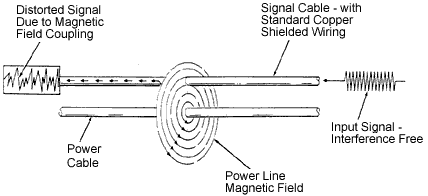AMAZON multi-meters discounts AMAZON oscilloscope discounts
The easiest method to reduce magnetically-induced interference is to use twisted pair wires. This is suggested for both shielded and unshielded cables and for interference generated by shield currents, or from other sources. Twisting wires (or wire strands) draws them close together, reducing the loop area and , hence, the induced voltage. Because currents are flowing in minimum-loop areas, the magnetic field generated is also reduced. Twisted-pair wire or cable effectiveness increases with the number of twists per unit length.

Above: Fig. 1: Effect of Magnetic Field on Signal Cable without
EMI shielding. The input signal is interference-free until it encounters
the power line magnetic field (or another magnetic field), which then
causes a distorted signal in the equipment.
Above: Fig. 2: Effects of Magnetic Field on Signal Cable with
EMI shielding. EMF shielding provides protection for the input signal that's susceptible to magnetic field induction, in addition to electrical
fields, until the signal is safely within the desired electrical/electronic
equipment.
Above: Fig. 3: Here is a cable whose conductors are mostly protected from
an external EMI. Notice that this cable has an outer low-permeability
shield braided over a high permeability shield. The incident radiation
of external EMI strikes the outside surface of the outer shield (the first
boundary-reflection loss area) where some of the radiation is reflected.
The radiation then penetrates into the material, layer by layer, where it's effectively absorbed (neutralized).
Here are some applications or requirements that
may necessitate the use of EMI-protective cables:
- You need to minimize the requirements for segregation and special routing of power and signal wiring and interconnecting cables
- You need effective protection from the effects of electromagnetic pulses (EMP), as in military applications
- You need cabling that's less sensitive to poor-voltage standing wave ratio (VSWR) conditions than coaxial cable
When looking for EMI-protective cables, from a particular manufacturer, look for these comprehensive set of features:
- Provides electrostatic shielding
- Attenuates electrical field interference
- Protects conductors from external magnetic fields
- Provides metal armor protection for conductors
- Is able to "contain" source of EMI
Here's what a high-quality, EMI-protective, twisted-pair cable looks like: